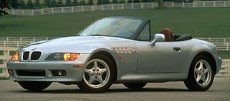 Back
in 1994, when I heard the rumours about a BMW roadster from European
magazines,
I expected to see a real driver's car that provide unmatchable driving
fun. After its launch in 1996, I am a little bit disappointed - that
does
not mean that BMW Z3 is a bad car, no, definitely not, but because we
used
to rate BMW cars as the best drivers' cars in the world. Back
in 1994, when I heard the rumours about a BMW roadster from European
magazines,
I expected to see a real driver's car that provide unmatchable driving
fun. After its launch in 1996, I am a little bit disappointed - that
does
not mean that BMW Z3 is a bad car, no, definitely not, but because we
used
to rate BMW cars as the best drivers' cars in the world.
Maybe we cannot over-expect Z3. In order to reduce cost, BMW installed it with the previous 3 series rear suspension (semi trailing arms) and assemble it in south USA. The former limits its handling ability and the latter leads to a lower build quality, though BMW will never admit. Also because of cost problem ( why always this problem? Z3 is not cheap! ), Z3 has to satisfy with the existing engines from the 3 series, i.e., 115hp 8 valves 1.9 litres four, 140hp 16 valves 1.9 litres four, 193hp 2.8 litres six and 321hp 3.2 litres six ( which calls "M Roadster" instead of "Z3M" ). The four cylinders, with which the majority Z3s will install, are less sweet than MGF's VVC engine and Alfa Spider's 2.0ts unit. On the contrary, the 2.8 litres version is very strong. It can outperforms all rivals bar the Porsche Boxster, and delivers lovely character. Nevertheless, higher price means that it may face tough competition from the brilliant Boxster and Mercedes SLK. Road
tests found Z3 has a very solid chassis and grippy tires, thus fast
attack
on bends would feels nothing other than secure. Nevertheless, it lost
the
involving steering that appeared in 3 series and 5 series, and lacks
the
adjustability that made Mazda MX-5 so thrilling. To BMW, this
disadvantage
is more serious than its strange look. |
| The above report was last updated in 1998. All Rights Reserved. |
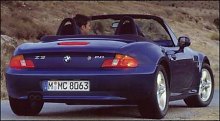 So
far the sales is quite successful, but bearing in mind the Honda S2000
and Audi TT Roadstser are on the pipeline, Z3 has been given a facelift.
So
far the sales is quite successful, but bearing in mind the Honda S2000
and Audi TT Roadstser are on the pipeline, Z3 has been given a facelift.
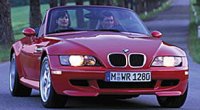 The objective of M Roadster
is quite mystery. By slotting the 3.2 litres 321hp straight 6 from the
M3 into the Z3 chassis (updated: now the new M3 engine, but with 325hp
instead of 343hp because of more restricted exhaust system due to
limited
space), further with bigger tyres and other necessary tuning, BMW has
created
a roadster which could blew all other competitors away in terms of
performance.
However, is it necessary and appropriate ? I don't think so.
The objective of M Roadster
is quite mystery. By slotting the 3.2 litres 321hp straight 6 from the
M3 into the Z3 chassis (updated: now the new M3 engine, but with 325hp
instead of 343hp because of more restricted exhaust system due to
limited
space), further with bigger tyres and other necessary tuning, BMW has
created
a roadster which could blew all other competitors away in terms of
performance.
However, is it necessary and appropriate ? I don't think so.
 For
the most demanding drivers, the newly launched Z3 M Coupe must be a
better
choice than the open top M Roadster. Why ?
For
the most demanding drivers, the newly launched Z3 M Coupe must be a
better
choice than the open top M Roadster. Why ?
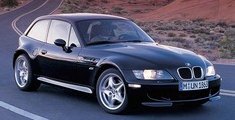 The
relatively weak chassis
deteriorate M Roadster's handling as well as ride. Although BMW set the
suspensions stiffer to compensate the lack of chassis rigidity, the M
Roadster
was still criticised as "excessive bump steer", "rides very hard",
"vibration
transmit to the dashboard thus causing the steering wheel shakes",
"heavy
steering wheel but responds slowly", "lack of agility and sensitive"
blah
blah blah.... Autocar even said the TVR Chimaera is more pleasant to
drive
yet more refined !
The
relatively weak chassis
deteriorate M Roadster's handling as well as ride. Although BMW set the
suspensions stiffer to compensate the lack of chassis rigidity, the M
Roadster
was still criticised as "excessive bump steer", "rides very hard",
"vibration
transmit to the dashboard thus causing the steering wheel shakes",
"heavy
steering wheel but responds slowly", "lack of agility and sensitive"
blah
blah blah.... Autocar even said the TVR Chimaera is more pleasant to
drive
yet more refined ! 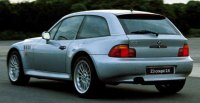 You
might dislike its odd
hatchback design. It doesn't matter to me, because I used to dislike
the
styling of Z3. Someone may accuse it of imitating the classic MGB GT.
Who
care ? BMW is the boss of Rover and MG !
You
might dislike its odd
hatchback design. It doesn't matter to me, because I used to dislike
the
styling of Z3. Someone may accuse it of imitating the classic MGB GT.
Who
care ? BMW is the boss of Rover and MG !